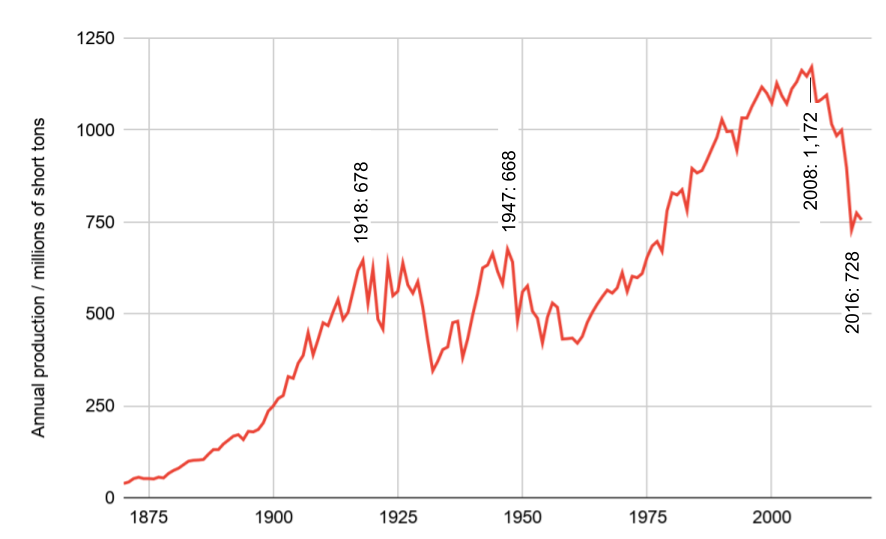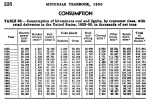EE were clearly offering by 1958 a 2500hp engine to fit into the class 40. Whether that is intercooled or not is uncertain, but it was offered, BTC wanted it, BR ignored it. It rather seems to me it was that intransigence from BR that forced EE to build DP2 to try and break the pro-Sulzer mindset within BR.
But the fact remains that by the late 1950s EE had both a suitable engine and the Deltic bodyshell available and they could have been paired much earlier
Re the brakes, I can only hazard a guess that as the pony truck would have been unsprung the extra weight of brakes would have caused uncontrolled pitching and would have been a hammerblow risk. Besides which, figures I've seen somewhere in the past suggested they didn't carry much weight anyway so the added braking force wouldn't have been significant.
I can't lay my hand on it at the moment to confirm my memory but I am reasonably confident that Harold Holcroft reports in his book
An Outline of Great Western Locomotive Practice 1837–1947 (Ian Allan 1971, a reprint of the original 1947 book) that the GWR used to brake the leading bogie of at least some of its 4-6-0s. Churchward ran some trials before the First World War to see if these brakes shortened the braking distance. It was found that their absence made no noticeable difference so Churchward had all the brakes removed and saved all the complication and maintenance requirements and built no further locomotives with them.
The bogie brakes are visible in this image of 4011
Knight of the Garter dating from 1911 which may be found in the Flickr archive at
https://www.flickr.com/photos/124446949@N06/36030757456/
Added in edit:
The bogie was sprung - at least it had primary springs over each axlebox. The frame is suspended by a system of swing links to permit it to have some lateral freedom but at the moment I cant remember whether these links also had some secondary suspension.
Here I am again! I’d like to make some further comments to some of the remarks made to my earlier posts.
I still maintain that there was sufficient diesel fuel available in the country in the 1947 to 1950/1 time frame to power a couple of dozen development locomotives of Ivatt’s original design without breaking the bank. As I wrote earlier burning oil in a locomotive firebox is incredibly wasteful, for the same power output three to four times as much oil is needed and the locomotive still needs to burn oil during its standby periods. The efficiency was no better than a coal fired steam locomotive. There were undoubtedly issues with the Government buying oil from the USA in dollars after the end of Lend-Lease but this narrative of lack of dollars omits two important considerations:
Firstly, the post-war American (and Canadian) loan in 1946 to the UK gave the Government a shot in the arm for dollar fluidity but further indebted Britain to the U.S above that of the Lend-Lease items still to be paid for. The Lend-Lease items retained were sold to Britain at 10% of nominal value, giving an initial loan value of £1.075 billion for the Lend-Lease portion of the post-war loans. Repayment was to be stretched out over 50 annual payments, starting in 1951 and with five years of deferred payments, at 2% interest. The final payment of $83.3 million (£42.5 million), due on 31 December 2006 (repayment having been deferred for the allowed five years), was made on 29 December 2006 (the last working day of the year). After this final payment Britain's Chancellor, Ed Balls, formally thanked the U.S. for its wartime support.
Secondly Marshall Aid was received from 1948. I can do no better than quote from Norman Davies' book Europe - A History (Pimlico 1997) page 1064:
On 5 June 1947, at a Harvard Commencement speech, Truman's Secretary of State, General George Marshall, unveiled plans for a European Recovery Program. "It is logical", he declared, "that the United States should do whatever it is able to do to assist in the return of normal economic health in the world, without which there can be no political stability and no assured peace". In contrast to the 1920s, the USA was offering to finance Europe's recovery in the interests of the common good. The Marshall Plan ran for four years, from 1948 to the end of 1951. It dispensed a total of $12,500 billion to 16 participating members. To manage the funds, it required the establishment of the Organisation for Economic Co-operation and Development (OECD), which insisted that recipients increase production, expand trade, and make 'counterpart contributions' of their own. Although one quarter of Marshall Aid was earmarked for Britain and one-fifth for France, it was available to allies, neutrals, and ex-enemies alike. It has no peer in the history of enlightened self-interest.'
So, between 1948 and 1951 Britain received over $3 billion in aid in then dollars. Britain was the single biggest recipient, receiving twice as much as West Germany. The trouble was - it was mostly wasted in current rather than capital expenditure. Little was invested in business such as happened in, for example, Germany through the
Kreditanstalt für Wiederaufbau and its successors as a rolling investment fund, or the French government electrifying its railways or the Belgium government rebuilding the docks in Antwerp. As far as one can tell the UK Governments of the time treated it simply as another flow of tax revenues.
Some Government department may have found it difficult to get sufficient dollars out of the Treasury to buy oil in the quantities needed to throw it up the chimneys of 1200 oil-fired steam locomotives. But I suspect that the lack of dollars became a suitable smoke screen to disguise what was an awful decision in the first place quite apart from the Government not wanting to be seen taking work away from another of its newly nationalised industries. But claiming that there were not enough dollars in the country by 1948/1950 to buy sufficient oil to power, at the outside a couple of dozen 1600/2000bhp diesel locomotives is a nonsense.
To other things…!
Regarding the possibility of BR remaining profitable after the war, the suggestions I made were simply intended as examples of trying to think differently. I have already stated that I don’t think BR could have remained profitable in the 1950s with the availability of reliable and more comfortable motor cars and the changes in the structure of Britain’s industry and its products. As I said, the BTC and RE were clinging to the past although it was quite clear by the end of the war in Japan that the world had changed dramatically. I agree that eventually technical and econonomic changes trump organisational issues but the point remains that nationalisation in the form chosen and the outdated constraints on the railway’s freedom of commercial action in the form of rate setting, freedom to select traffic and Government controls on wages and conditions of service delayed any serious changes by between 10 (Modernisation Plan) and 15 years (Beeching Report). All this meant that the finances went to pot and motive power development essentially stopped for 10 years (the few electrification schemes were all pre-war concepts).
The suggestions I made for changes (a Japanese model or getting into the international travel business) were intended to be examples of what could have happened to improve the financial situation if business people rather than civil servants of military people had been in charge. Instead of criticising the suggestions why not show some imagination and suggest some other models which could have expanded the business outside its rigid framework of only supplying internal land transport. A national business constrained to offer only transport services has no chance of expansion
to bring in more money.
I do not disagree that Western European rail networks are an obvious point of comparison with the British rail network, but as the situation in which many of them found themselves at the end of the Second World War was so abnormal and so very different to that pertaining in the UK at the time I am having difficulty in understanding why a study should be ‘instructive’ which implies that the UK could have learned something. But in this context see also above about the use of the Marshall Aid monies.
Regarding bogies…
…the Co-Co bogies under 10000 and 10001 were designed at Derby but based on US practice. Externally, at least to me, they look to be similar to those used under the EM2 electric locomotives for the Woodhead line, but I don’t know if there is any common history. The bogies for the Deltic prototype were, as far as I know, a purely English Electric design but of course all Co-Co bogies have similarities, there are only so many ways of laying out the springs and other gubbins at any particular level of technology.
The original welded version of the EE Co-Co bogie showed weaknesses when used continually at high speed and the production Deltics soon received bogies with cast frames. I think some of the Type 3s (Class 37 to you youngsters!) also received cast frame bogies.
The 1-Co-Co-1 bogie used under the EE Type 4s (Class 40) was almost identical to that used under the Southern Railway’s diesel locomotives 10201, 10202 and 10203. In turn this was essentially the same as Bulleid’s Co-Co bogie for the SR’s electric locomotive CC1 of 1941 but with an additional pony truck to carry the extra weight of the diesel engine and cooler groups. The bogie had no secondary suspension, the body rotated on quadrants attached to the top of the frames, and there was a tendency for the side frames around the horn guides to crack. BR was developing a modified primary suspension using long swing links to alleviate the problem but the locomotives were withdrawn before it was generally applied. The Peak class’s bogie is obviously similar but I am unaware if was based on the SR/EE design.
I’ll try to address the issue of the decline of the home-grown rolling stock industry in a subsequent post as it is also tied up with the Governments’ industrial policy in the 1960s and this post is too long anyway.


